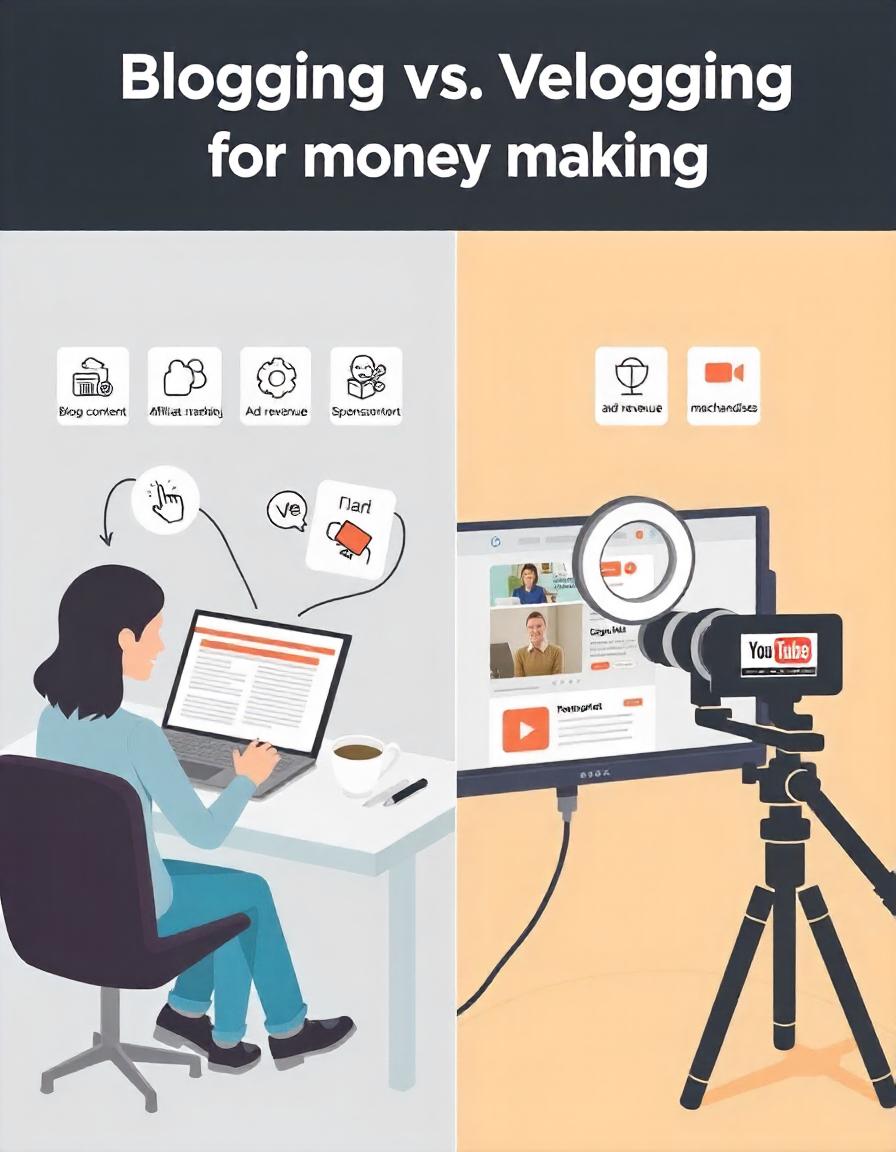Blogging vs. Vlogging Money: Which One Is More Profitable?
In the world of content creation, both blogging and vlogging have become powerful avenues for individuals to generate income. However, while both platforms offer opportunities to make money, they differ significantly in terms of the methods used to earn, the audience engagement, and the overall earning potential. In this article, we’ll explore the key differences between blogging and vlogging when it comes to making money and which one could be more profitable for you.
How to Earn Money Online – The Ultimate Guide to Financial Freedom!
1. Monetization Methods
Blogging: Blogging provides various monetization methods that bloggers can leverage to generate income. Here are some of the most popular ways bloggers make money:
- Affiliate Marketing: Bloggers can promote products or services on their websites and earn a commission for each sale made through their affiliate links. This is one of the most common methods, especially for bloggers who write about niches like fashion, tech, or lifestyle.
- Sponsored Posts: Brands often pay bloggers to write posts featuring their products or services. Sponsored posts can range from a few hundred to thousands of dollars, depending on the blogger’s audience size and niche.
- Advertising: Bloggers can display ads on their site through networks like Google AdSense. The more traffic a blog generates, the more money can be earned from ad impressions or clicks.
- Selling Products or Services: Many bloggers sell their own products (like eBooks, online courses, or merchandise) or offer consulting services. This direct monetization can be highly profitable if the blog has a dedicated audience.
How to Earn Money Online – The Ultimate Guide to Financial Freedom!
Vlogging: Vlogging, especially on platforms like YouTube, also offers various ways to earn money, but with some unique opportunities:
- Ad Revenue: Vloggers can earn money through YouTube’s Partner Program by displaying ads on their videos. Earnings are based on views, ad clicks, and the type of ads shown. YouTube’s monetization is typically based on CPM (Cost Per Thousand Impressions), meaning the more views a video gets, the more money can be made.
- Sponsorships and Brand Deals: Just like bloggers, vloggers can collaborate with brands for sponsored content. Brands pay influencers or content creators to promote their products within the video, often in an organic way that resonates with the audience.
- Super Chats and Donations: Platforms like YouTube and Twitch allow vloggers to receive donations or tips from their audience, especially during live streams. Fans can send money during live broadcasts to show their support or appreciation.
- Merchandise Sales: Vloggers, particularly those with a large and loyal following, can create and sell merchandise, like T-shirts, mugs, or hats, directly to their fans. This direct-to-consumer model can be very profitable, especially with strong brand recognition.
2. Audience Engagement and Reach
Blogging: Bloggers tend to have more control over their content, and they often cater to a specific niche audience. While the potential reach of a blog can be extensive, the audience may be smaller compared to vloggers, especially in highly competitive niches. However, blogs allow for in-depth, detailed content that attracts dedicated readers who trust the blogger’s expertise.
Blogging also allows for longer engagement times, with readers often spending more time on a blog post. This provides more opportunities for conversion when using methods like affiliate links or selling digital products. That said, building an engaged blog audience takes time, and the process may require consistent SEO efforts and marketing.
Vlogging: Vloggers tend to reach a broader, often younger, audience due to the visual and engaging nature of videos. Platforms like YouTube are global, meaning vloggers can quickly tap into an international audience, sometimes reaching millions of views on a single video.
Video content allows vloggers to connect with their audience on a deeper level through body language, tone, and personality. This emotional connection often leads to more loyal followers who are eager to support the vlogger through donations, merchandise purchases, or paid subscriptions.
The downside is that vloggers face more competition due to the sheer volume of video content being uploaded. However, with high-quality content and consistency, vloggers can build massive followings more rapidly than bloggers can.
How to Earn Money Online – The Ultimate Guide to Financial Freedom!
3. Startup Costs and Equipment
Blogging: Starting a blog typically requires lower upfront costs. All you need is a domain name, web hosting, and possibly a website theme or design. With a basic setup, you can start blogging for as little as $50 to $100, depending on your hosting provider.
That said, if you plan to create high-quality digital products, run paid ads, or hire content writers, the costs could increase over time. However, the barrier to entry for blogging is relatively low compared to vlogging.
Vlogging: Vlogging requires more investment in equipment, especially if you want to produce high-quality videos. At a minimum, vloggers need a decent camera, microphone, and lighting setup, which can cost anywhere from $500 to $2000 or more, depending on the quality desired. Additionally, video editing software and sometimes a dedicated studio space may be required for professional-looking content.
The initial investment for vlogging can be significant, but the potential to reach a wide audience quickly can justify the expense if you’re producing high-quality content consistently.
How to Earn Money Online – The Ultimate Guide to Financial Freedom!
4. Long-Term Income Potential
Blogging: Blogging can provide a steady stream of passive income, particularly through affiliate marketing, sponsored posts, and ad revenue. Successful blogs can continue to generate income long after the initial content is published. However, consistent traffic is necessary to keep this income stream flowing, and it often takes several months or even years to build a blog that generates significant revenue.
Vlogging: Vlogging also has long-term income potential, especially if a vlogger’s content goes viral or they become a recognized influencer in their niche. However, it’s more difficult to achieve viral success compared to blogging, and success often depends on maintaining a consistent upload schedule, adapting to audience preferences, and keeping up with trends.
With a larger audience, vloggers can secure more lucrative sponsorships and opportunities for paid collaborations, which can significantly boost their earnings.
How to Earn Money Online – The Ultimate Guide to Financial Freedom!
5. Which Is More Profitable?
Ultimately, both blogging and vlogging offer significant opportunities to make money, but the potential profitability depends on several factors:
- Blogging might be more profitable if you are consistent with SEO, content creation, and diversifying your income streams (like affiliate marketing, product sales, and ad revenue).
- Vlogging can be more profitable if you build a large, loyal audience, secure brand deals, and leverage various monetization options like merchandise and sponsorships.
For individuals with strong writing skills who enjoy creating detailed content, blogging can be an excellent choice. On the other hand, if you’re comfortable in front of the camera and enjoy creating engaging visual content, vlogging could be the right path for you.
How to Earn Money Online – The Ultimate Guide to Financial Freedom!
In the end, the most profitable option comes down to your personal skills, the type of audience you want to reach, and how effectively you can monetize your content. Many successful content creators even combine both blogging and vlogging to maximize their earning potential and diversify their income streams.







